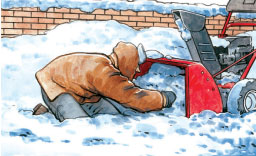Each year, about 5,700 people in the United States go to the emergency room for treatment of snowblower-related injuries such as broken bones, cuts to skin and soft tissue, bruises, and sprains. About 10 percent of injuries involve amputation of the hand or fingers.
 Snowblower injuries tend to happen when someone stops paying attention for even a few seconds.Even after the snowblower is turned off, tension is stored in the rotor blades. A hand or finger stuck in to remove wet snow or ice is at risk for being cut, mangled or even amputated.
Snowblower injuries tend to happen when someone stops paying attention for even a few seconds.Even after the snowblower is turned off, tension is stored in the rotor blades. A hand or finger stuck in to remove wet snow or ice is at risk for being cut, mangled or even amputated.
To stay safe, keep your hands and fingers out of the snowblower mechanism whether the machine is running or turned off. Do not disable the safety devices built into most new snowblowers and take the time to review the key safety features in the owner’s manual.
